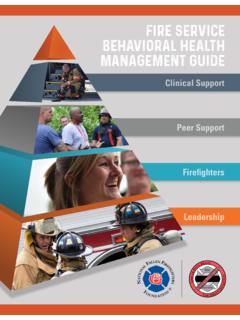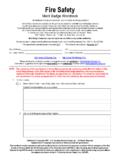Transcription of Striking the balance between operational and health and ...
1 health and Safety Executive Striking the balance between operational and health and safety duties in the fire and Rescue Service Foreword This statement is intended to clarify how the fire and Rescue Service should comply with health and safety at work duties within their operational work. The statement and subsequent guidance should assist fire and Rescue Authorities in balancing risks, particularly in their wider role to protect the public and property, while meeting their health and safety at work duties to protect their staff and others. HSE recognises that firefighters and managers face difficult moral dilemmas and have to make decisions in what are sometimes extremely hazardous, emotionally charged and fast moving situations.
2 HSE initiated joint work with fire and Rescue Service leaders to clarify how fire and Rescue Authorities can strike the balance between their operational and health and safety duties. The result of this collaboration is set out in the attached set of principles, which are by their nature high level and will be underpinned by further guidance. Geoffrey Podger Judith Hackitt Chief Executive Chair HSE HSE 1 of 5 pages health and Safety Executive Introduction There has been some concern and misunderstanding about how fire and Rescue Authorities can comply with health and safety legislation in their operational work, given the often difficult circumstances in which they are called upon to act.
3 HSE is therefore publishing this statement of principles in order to help employers, HSE inspectors and the public understand how fire and Rescue employers can comply with health and safety requirements to safeguard the public and their own staff while providing an effective emergency service. HSE has worked with fire and Rescue Service leaders and other stakeholders, including representative bodies, in developing these principles. This statement will be supported by practical guidance. Through this collaborative work the aim is to: help firefighters, other staff and the public understand the practical application of health and safety law to the operational work of the fire and Rescue Service; ensure consistency of approach and in decision making by HSE inspectors; promote a culture within the fire and Rescue Service where hazards are dealt with in a sensible, proportionate and thought-through manner.
4 Set out the expectations on the fire and Rescue Authorities, as employers, in relation to the management of those of their operations that can be hazardous, fast moving and emotionally charged; and provide mechanisms for ensuring early and wide learning from incidents, new developments and research. Principles Particular challenges for fire and Rescue Authorities as employers The application of health and safety law is challenging for fire and Rescue employers in relation to some of their operational activities because: they have to send firefighters into dangerous situations in order to save lives when anyone else would be seeking to get away from the danger; there is often an unrealistic public expectation that firefighters will put themselves at risk even when such risks outweigh any potential benefits to be gained.
5 Many incidents firefighters face can develop at speed, some can develop in unexpected ways and firefighters may, from time to time, be confronted with situations outside their experience; they have to prepare individual employees to be able to make decisions in dangerous, fast-moving, emotionally charged and pressurised situations, even when there may sometimes be incomplete or inaccurate information about the incident; they have to respond to dangerous situations which are not of their own making this is different to most other sectors where it is the employer s own business that creates the hazards; and they may not be able to control or mitigate some aspects of the working environment.
6 health and safety duties In Great Britain, the health and Safety at Work etc Act 1974 (HSWA) applies to all activities of fire and Rescue Authorities as the employers of fire and Rescue Service staff. Striking the balance between operational and health and safety duties in the fire and Rescue Service 2 of 5 pages health and Safety Executive HSWA requires employers to ensure the health , safety and welfare at work of their employees and that their operations do not adversely affect the health and safety of other people. These health and safety duties are not absolute and each is qualified by the test of what is reasonably practicable.
7 HSWA, therefore, does not require all risks to be eliminated, and HSE recognises that, even when all reasonably practicable precautions have been taken to deal with foreseeable risks, harm could still occur. HSWA also places duties on employees to take reasonable care of themselves and others and to co-operate with their employer. In essence, this means that employees should act sensibly and responsibly within the command and control of their employer; they should not act recklessly. Safety Representatives have the legal right to represent their members and be consulted on health and safety issues and have a key role in improving standards of health and safety management.
8 What employees should expect of the fire and Rescue Authorities as employers Good health and safety management systems that: take account of the wider context in which they operate, so that the fire and Rescue Authorities can: deliver an effective and realistic service; and enable staff to take appropriate care for their own, their colleagues and the public s health and safety; are based on robust, proportionate, carefully considered and non-bureaucratic risk assessments which: identify significant hazards; set out safe systems of work, including appropriate control measures, equipment, competencies and training; and are effectively implemented; include arrangements for monitoring health and safety performance, including learning from incidents and using this information to improve performance; and include arrangements for consultation with employees and their representatives.
9 What the fire and Rescue Service can expect from HSE HSE will continue to promote good health and safety management in the fire and Rescue Service through a range of activities including: communicating and listening with/to key interested parties across the fire and Rescue Service with a view to building and developing shared understanding of the issues that the Service faces (eg through regular informal discussions and formal meetings); working with key interested parties (eg employers, leaders, government departments, professional bodies and trades unions) through joint initiatives (eg the development of these principles and the guidance to underpin them),and in setting standards; acting to ensure consistency of approach and in decision making by HSE inspectors in the light of these principles; inspection and investigation - HSE inspectors will take appropriate action, as set out in HSE s Enforcement Policy Statement, these principles and underpinning guidance.
10 Such actions range from giving verbal and written advice, through the service of enforcement notices to prosecution; and Striking the balance between operational and health and safety duties in the fire and Rescue Service 3 of 5 pages health and Safety Executive training our inspectors to have an understanding of the work of the fire and Rescue Service. The primary duties under health and safety law are on employers. HSE inspectors, when inspecting or investigating an individual fire and Rescue Authority using HSE s own procedures, including the Work Related Death Protocols, will consider: the adequacy of the employer s plans, policies, risk assessments and procedures; if these policies are adequate, then the focus will be on how they are/were applied in practice - this may be illustrated by the preparedness of the service when dealing with foreseeable incidents; how the actions taken by that Authority measure up to what would be considered reasonable in the circumstances.

















